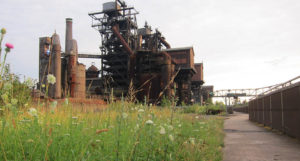Rainforest wildlife under threat as new research shows below-canopy temperatures are rising

A Guianan Cock of the Rock. Photo: Alexander Lees
Crucial strongholds for biodiversity are under threat as new research shows that temperatures are rising in tropical forests, the world’s most diverse terrestrial ecosystems.
It has been long assumed that the forest subcanopy and understorey – where direct sunlight is reduced – would be insulated from the worst climate change impacts by the shielding effect of the forest canopy.
A new study, published in Nature Climate Change, used a microclimate model to examine temperatures beneath the rainforest canopy across the global tropics, showing that between 2005 and 2019 most of the world’s undisturbed tropical forests experienced climate conditions at least partially outside the range of historic conditions. Many areas had transitioned to almost entirely new temperature averages.
Temperatures beneath the canopy in rainforests have remained relatively stable until recently, meaning that the wildlife that lives there has evolved within a narrow range of temperatures, leaving it poorly adapted to deal with temperatures outside this range.
The study showed that pronounced shifts in climate regimes in a significant proportion of tropical forests, including globally important national parks, indigenous reserves, and large tracts of ecologically unfragmented areas.
Recent studies in largely undisturbed and/or primary lowland tropical forests have found changes in species composition and significant declines in animal, insect, and plant populations. These changes are attributed to warming temperatures and are consistent with the findings of the research.
Dr Alexander Lees, Reader in Biodiversity at Manchester Metropolitan University, study co-author, said: “Our study challenges the prevailing notion that tropical forest canopies will mitigate climate change impacts and it helps us understand how to prioritise conservation of these key areas of biodiversity effectively.
“It is paramount that distant, wealth-related drivers of deforestation and degradation are addressed and that the future of those forests acting as climate refuges is secured by effecting legal protection and/or empowering indigenous communities.
“Notwithstanding the fundamental need for global carbon emission reductions, the prioritisation and protection of refugia and the restoration of highly threatened forests is vital to mitigate further damage to global tropical forest ecosystems.”
Dr Brittany Trew, Conservation Scientist for the Royal Society for the Protection of Birds, and lead author of the study, said: “Tropical forests, home to many of the world’s highly specialised species, are particularly sensitive to even small changes in climate.
“Our research shows that climate change is already impacting vast areas of pristine tropical forest globally. To provide species with the best chance to adapt to these changes, these forests must be protected from additional human-induced threats.”
Ilya Maclean, Professor of Global Change Biology at the University of Exeter and senior author of the study, added: “The world’s rainforests are incredible reservoirs of biodiversity, harbouring species that live in micro-environments in which climate conditions are generally stable. Thus, they are particularly sensitive to any changes brought about by climate change. It is vital that we take measures to safeguard these ecosystems from human pressures.”
Professor David Edwards, co-author of the study from the University of Cambridge’s Department of Plant Sciences said: “Tropical forests are the true powerhouses of global biodiversity, and the complex networks of species they contain underpin vast carbon stocks that help to mitigate climate change. A severe risk is that species are no longer able to survive within tropical forests as climate change intensifies, further exacerbating the global extinction crisis and degrading rainforest carbon stocks.”
The study was made possible through a global collaboration, including researchers at Mountains of the Moon University, Uganda, Universidade Federal do Pará, Brazil, Brazilian Agricultural Research Corporation and Universidad Nacional de San Antonio Abad del Cusco, Perú.



